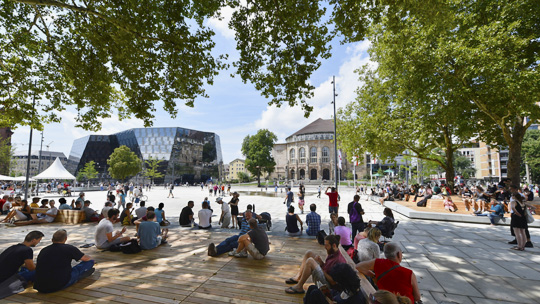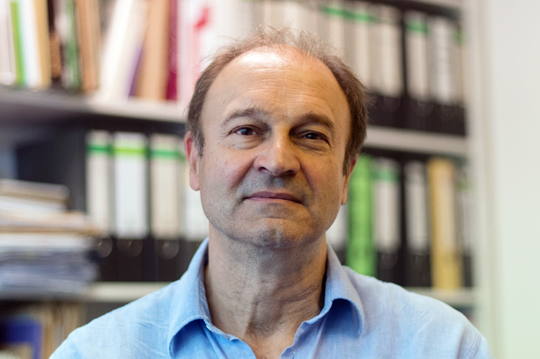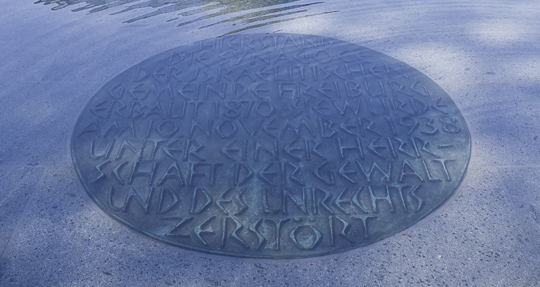Protecting a site's dignity
Freiburg, Aug 03, 2017
During the last decade, there has been a great deal of discussion about Old Synagogue Square. Much has been said about its design, its significance and its name. Now the refurbished square has been opened. Freiburg historian Dr. Heinrich Schwendemann spoke to Julia Dannehl. He explained how developments on the site unfolded in the past and about the significance the square will have for the city of Freiburg in the future.

Shortly after it was opened, Freiburg residents were enjoying the refurbished square. Photo: Thomas Kunz
Herr Schwendemann, why is the history of the Old Synagogue so important?
Heinrich Schwendemann: The medieval ban on Jews was in effect for a very long time in Freiburg. No Jews were permitted to settle in Freiburg until 1862. When Baden's Jews were finally permitted to choose their place of residence freely, above all young families from the surrounding countryside moved into the city. By 1870, there were already 300 Jews living in Freiburg. This was the year that the synagogue was built for the newly established Israelite community. Back then, the site was on the outskirts of town. The train station was there already, but the space between the synagogue and the station had not been built up yet. When the National Socialists' persecution of the Jews began in 1933, the Jewish community had around 1,250 members. They were predominantly members of the middle class bourgeoisie. In 1937, the so-called "aryanization" – forcing Jews from commerce and trade – was in full swing in Freiburg, and the city was already negotiating with the Jewish community about buying the synagogue. They wanted to tear it down and build something else on the site. During the Reichskristallnacht pogrom in 1938, SS and SA troops from Freiburg finally destroyed the building completely.
What happened to the piece of land after that?
There were different ideas – from a convention center to a student dormitory. In the end, the city came up with the interim solution of using it as a parking lot. After the war, a woman who survived Ravensbrück concentration camp, Gertrud Luckner, insisted that a memorial must be placed there. She herself had helped many Jews and after 1945 could've been described as "the city's bad conscience." Then there were some talks, but the issue kept getting swept under the rug. It wasn't until November 1962 that a memorial plaque was set into the ground on the site. But it soon caused controversy, because it was always overgrown with weeds

Heinrich Schwendemann finds the idea of naming the newly renovated area "Destroyed Synagogue Square" appropriate. Photo: Patrick Seeger
So the old memorial wasn't necessarily ideal. Do you find that the situation has improved with the square's refurbishment?
The historic site of the synagogue that was destroyed in 1938 must be kept intact as a dignified memorial. That was of course one of the aims of the renewal work. But there are two things about the renewal that I do not understand. First, one of the city's few, larger, green areas was eliminated from the old town. In my opinion, they could have made something more like a park, with more greenery and less stone. And second, I question why they didn't hold a dig at this square before planning and work began. It was highly likely that remains of the synagogue could have been found in the ground. After all, during the construction work they did uncover one corner of the walls. If they had searched earlier, they could've saved the remains of the walls and incorporated them in the memorial.
A reflecting pool in the footprint of the former synagogue has been set as memorial. Do you think this is an appropriate substitute?
This pool has certainly been set up with the best of intentions, but ultimately, it's more about esthetics than anything else. The remains of the foundation walls would have, by contrast, been a much more "awkward" memorial relic. Beyond that, I fear greatly that the water feature, particularly in summer, will be used as a wading pool. The large areas of stone and concrete on the square become really hot on warm days. The reflecting pool is there, inviting people to cool off. That's why I don't know if the dignity of the site can be maintained.

The memorial plaque unveiled in 1962 has been incorporated in the reflecting pool, the shape of which conforms to the outlines of the destroyed synagogue. Photo: Thomas Kunz
What happened to the memorial plaque that used to be located on the square?
The old plaque was set in the bottom of the reflecting pool. I think that's good because it simultaneously bears witness to how the Nazi past and along with it, history, was handled early on the Federal Republic. The inscription says: "The synagogue of the Israelite community of Freiburg once stood here. Built in 1870, it was destroyed on 10 November 1938 under a regime of violence and injustice." That was typical for back then. The perpetrators were made anonymous, with the blame placed on an abstract, violent regime. And the actual victims, who went to the Freiburg synagogue, don't get a mention.
Right now there's a discussion going on about whether "Old Synagogue Square" should be renamed as "Destroyed Synagogue Square." What do you think of the idea?
I think "Destroyed Synagogue Square" is appropriate. It describes accurately the situation in November 1938. Besides, in the Middle Ages there already was a synagogue in the city in the vicinity of what is Wasserstraße today. The Jewish community was settled there until it was wiped out in 1349. The previous name, "Old Synagogue Square," leads people to believe that there was only one synagogue in Freiburg during the city's history. But that isn't true.

